Conserving Banalité
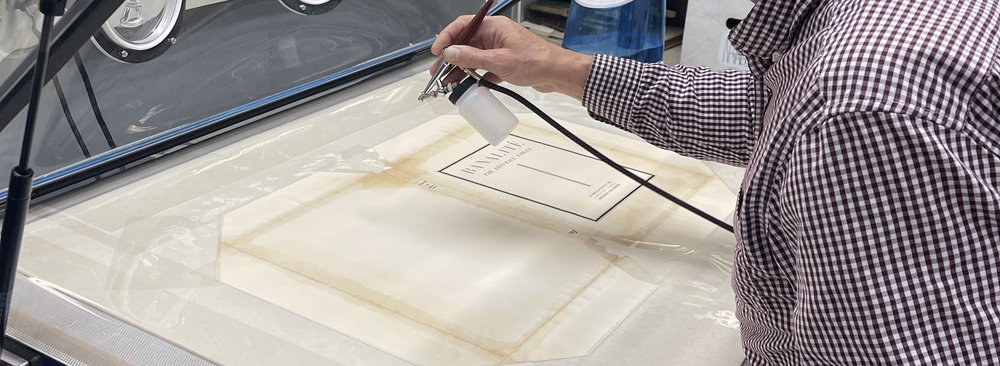
by David Stokoe, Conservation Librarian, Special Collections Research Center (SCRC)
Published in 1930, the SCRC copy of Banalité is exemplar number 33 (of only 300 created) and signed by both the author and the photographer, Leao-Paul Fargue and Roger Parry, respectively. Fargue’s poem, originally published without illustration, was paired with Parry’s photographs that utilized a variety of techniques, such as photomontage, solarization and negative print, making it a good representation of photobooks from the Surrealist art movement.
Early in 2024, Syracuse University Art Museum requested to loan the photobook as part of their Spring 2025 exhibition, Surrealism and Photography: “Where I Dream, It is Awake”. The exhibition, which examined the role of Surrealism in modern photography, was curated by graduate students in the Department of Art & Music Histories under the direction of Sam Johnson, Associate Professor and Director of Graduate Studies in Art History. It featured photographs from Syracuse University Art Museum alongside several Surrealist books and periodicals from SCRC that students selected from a Surrealism-themed instruction session with us at the Center. The loan of this photobook was agreed but the volume was in bad shape and in desperate need of some TLC (tender loving care) before it went on display for the duration of the exhibition.
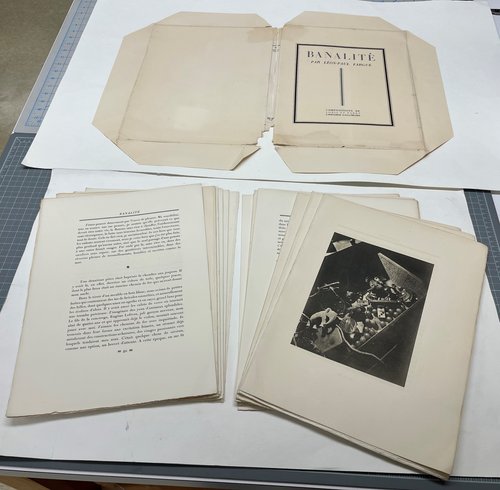
Cover and pages are disbound.
The unsupported sewing structure that bound the pages had broken, the outer paper cover was coming away at the spine and partly missing, and most edges and corners of the pages were weak or heavily worn. It was decided to disassemble the binding completely, repair the cover and page folds, resew the text block and re-unite the two like it never happened! The paper was not acidic so chemical stabilization was not required; the de-acidification process would have required washing pages in an alkaline bath prior to repair so they wouldn’t crumble from embrittlement.
After carefully separating the cover from the text block and checking pagination, the sewing was cut and the remaining glue removed from the outer page folds. The inner folds of each gathering of pages were reinforced with Japanese paper strips which have long cellulose fibers that make them ideal for repairs. The strips were adhered with wheat starch paste as adhesive reversibility (i.e., the ability to unadhere something adhered together) is a prime concern whenever possible in the conservation field!
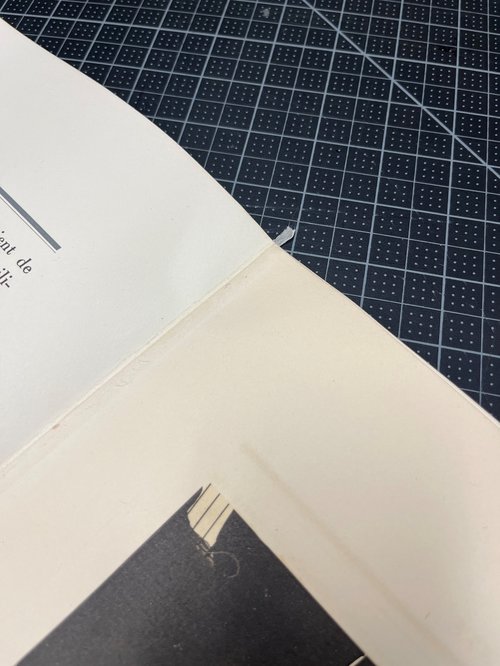
Page folds lined with Japanese tissue and wheat starch paste.
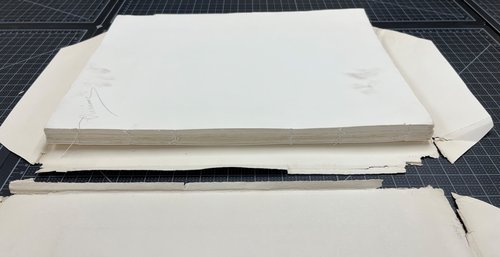
Checking that the repaired text block fits within the limits of the cover.
The text block was resewn using Irish linen thread and replicated the original unsupported sewing structure (no tapes or cords) and needle holes. Ensuring the text block would fit back inside the cover was always a prime concern!
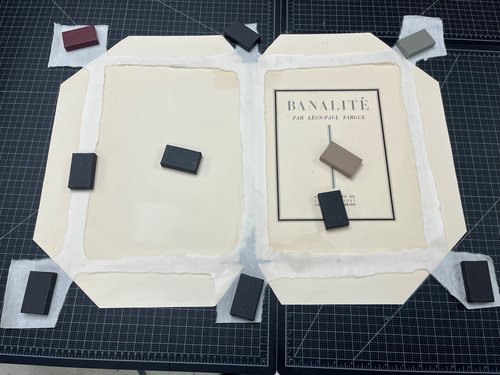
Japanese paper cover repair in process.
The cover was repaired using a stronger Japanese paper shaped from one sheet using a water pen to ensure fibrous edges, which spread stresses when flexed and stick better. Western papers have shorter cellulose fibers and different characteristics making them less suitable for repairs. Once shaped, the Japanese paper repair piece was dampened and positioned on the felt bed of the paper conservation vacuum table and pasted with wheat starch paste.
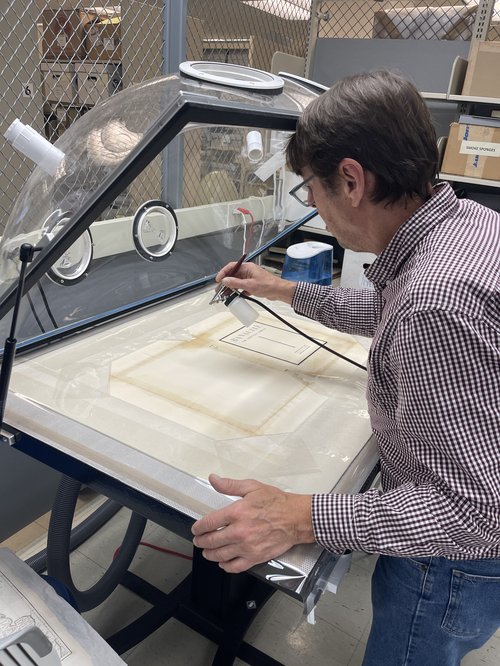
Conservation Librarian David Stokoe humidifies the book’s cover.
The cover was humidified using a spray gun then carefully laid into position on to the pasted repair paper and smoothed down. The vacuum pump was activated to suck the two parts together and begin the controlled drying process. Once thoroughly dry the repaired cover was removed from the vacuum table, excess repair paper was trimmed off and the turn-ins folded over.
The text block spine was lined with Japanese paper and once dry, the finished cover was re-adhered with wheat starch.
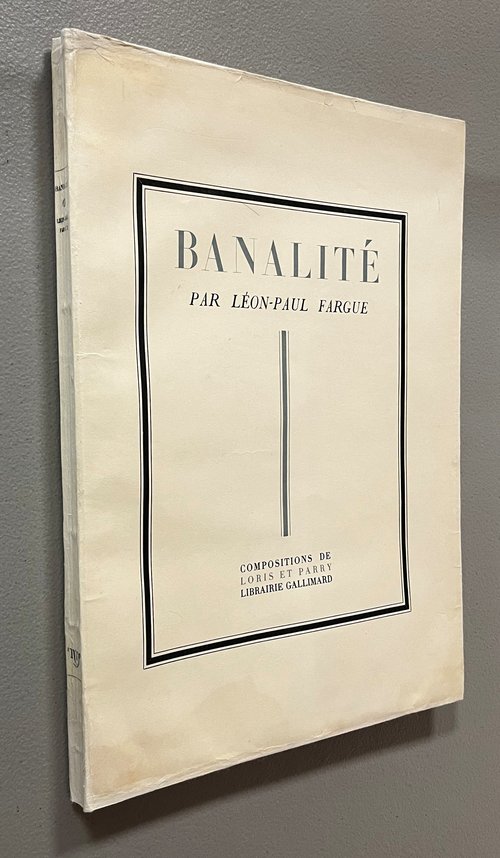
Fin: Banalité after its full conservation treatment.
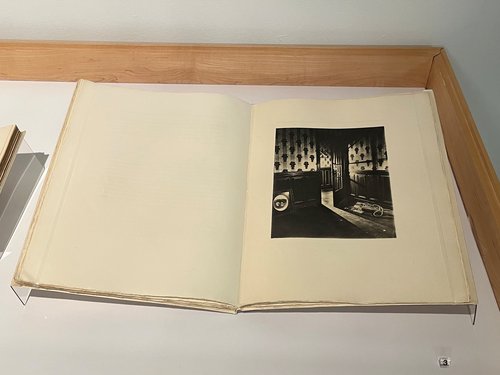
Installed photobook on a Vivak custom-made cradle.
A display cradle was constructed out of Vivak (bendable inert plastic) and the finished book was installed as part of the Spring exhibition at the Syracuse University Art Museum. In addition to the repairs made to the book itself, the finished book was measured and custom boxed using our computerized box-making machine in acid-free pH buffered corrugated board for protection during transportation and future storage.
Further Reading: You can see our computerized box-making machine in action in this video
